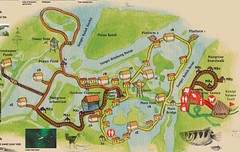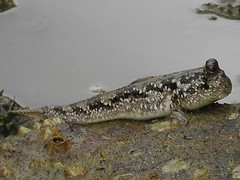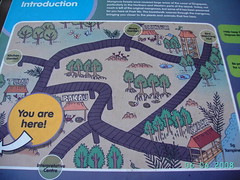Thursday, September 4, 2008
The lord of the mudflats
Apparently, the distinguishing black lateral stripe coursing posteriorly down Periophthalmodon schlosseri was believed to be a display that is shown only when the mudskipper is agitated or threatened.
Reference:
Murdy, E. O., 1986. Mudskippers of Malaysia. The lords of the mudflats. Freshwater and Marine Aquarium 9:20-23.
Personal communication with Prof Ip
1. The secondary fused lamellae of the gills of Periophthalmodon schlosseri is a telling difference should I find it difficult to tell it apart from another species.
(Problem is, I have not been able to even lay my hands on one!)
2. When a mudskipper "disappears" into a burrow, it is not necessary its own.
themudskipper.org
The species list taught me about the genera of mudskippers I am working on. Periophthalmodon has three species while Periophthalmus is the largest genus from the subfamily of Oxudercinae, with 17 species.
I love the applet (?) of a mudskipper on his site. It actually displays its dorsal fins!
Pandan mangroves 04-09-08
The back mangrove that is near to the road, and where a small stream flows consistently, a microhabitat containing many juvenile Periophthalmus argentilineatus is spotted. Further down the stream is where Paul, Marcus, Danny and me wait in anticipation to scan for any movement from the "wanted species number one" --- Periophthalmus walailakae.
When the tide was coming in today, we discovered the hot spot for "wanted species number two" --- Periophthalmodon schlosseri. I have yet to catch any of this species. Sigh. Mind you, we tried cast nets and tow nets today, on top of long hand nets.
Next up, weaving lessons for me (to make a trap).
Ps. Pandan mangrove smells bad; but Lim Chu Kang will always be my first love, not.
Saturday, July 26, 2008
Pulau Ubin on 22/07/08
Tide: Rising to high
Time and tide waits for no man.
I reached Pulau Ubin when the tide is rising. Enough said.
The worst thing to commit when looking for mudskippers. Mid-tide is alright, but when we reached Pulau Ubin as the tide is rising, it is clearly impossible to recce all the different sites to check what is where.
I managed to get to Sungei Ubin before, so I knew that there are B. boddarti and Pn. schlosseri at the prawn ponds beyond the sluice gates. But when I reached there on my rented-for-$5 bike, the only mud flats exposed are beyond the power of the Opticron binoculars to be able to distinguish any mudskippers apart. However, I did see one Ps. walailakae above 10 in length a mere metre before me. There also about 5 other small ones in front of me but I was too engrossed with the large one.
I tried to go to the three bridges overlooking Sungei Mamam but the trail is closed to public!
Then Sungei Jelutong which was our last stop was obviously at high tide when we reached there.
SBWR Mangrove Arboretum on 21/07/08
Tide: mid-tide to rising tide
One thing I learnt from this recce may be that there may be some form of habitat partitioning between Periophthalmus walailakae and Periophthalmodon scholsseri after all. At the Mangrove Arboretum, on the boardwalk from MA1 to MA2, there are many Pn. schlosseri seemingly "basking" themselves in the open. There were only 3 Ps. walailakae in more sheltered area in between MA1 and MA2. After MA2 in the covered canopy area where many tree-climbing crabs are roaming freely, there are more of the smaller burrows as well as their owners - Ps. walailakae.
Pn. schlosseri is also seen to be feeding, doing burrow maintenance as well as displaying territorial behaviors.
Sunday, July 20, 2008
LCK recce on 19/07/08
Edward, Theresa
The mangrove in Lim Chu Kang has a shape like that of a rectangle framed by the coast and fences that act as a barrier between the mangrove and the part of the mangrove that has been cleared away for farm use.
The Lim Chu Kang mangrove is also just adjacent to the Sungei Buloh Wetland Reserve, found in the Northwestern coast of Singapore.
We spotted many small and beautiful Boleophthalmus boddarti and Edward also caught one in his hand net. Feeling our presence, they also flared their pretty yellow dorsal fins at us. In addition, we saw countless Periophthlamus walailakae as well, with the largest one spotting a size about 15 cm long!
Just as we get really fired up trying to catch the mudskippers using stalking, trapping, cornering methods, it had to start raining. Coupled with the fact that the tide was already rising at about 1030a.m., we decided to call it a day. Then we found out that it was a real good idea since the stream where water flow came in from was already more than 1 metre wide, meaning the tide is slowing filling the mangrove bed.
Ps. when the tide is rising and there is rain, try to evacuate asap as it will mean tide will be rising faster than expected.
Friday, July 4, 2008
SBWR recce on 25/06/08

The low tide for that day was at 11am but the time at which we were let off from our fieldtrip was about 1pm. Basically, there was a race against time to check out the mudskippers at the Mangrove Arboretum Boardwalk.
Armed with a camera which has zooming power much left to be desired and a pair of binoculars, I spotted more than 20 Periophthalmodon schlosseri just from MA1 to before MA2! Comparatively, there were lesser of Periophthalmus walailakae (like only 2!).
After which, the tide rose, period.
Ps. the mudskippers spotted were those nearer the boardwalk.
Wednesday, June 25, 2008
Recce at Lim Chu Kang Mangroves 21/06/08
People present: Airani, Siva, Edward and me
After meeting at 8am at the Lim Chu Kang jetty, we walked past the rubbish-strewn coast at the front of the mud lobster mounds and headed in to the mangrove.
This mangrove is supposedly in its pristine conditions as little or nothing is man-made or artificially planted. The mud lobster mounds were big and numerous, supporting a healthy population there, I suppose. Afterwhich, we followed a stream, which opened into the sea, and headed into the mangrove forest. As compared to Sungei Buloh which is just “next door”, I am surprised by the canopy cover of Lim Chu Kang. The root system of the area has almost filled up the entire area except for the stream banks.
The burrows of larger sizes were found only next to the stream if there is a patch of area not covered by the pneumatophores. The smaller mudskippers were more readily seen and associated with the stream line while I really scratch my head about where are the bigger ones?
Since the giant mudskipper is a obligate aerobes, it would not be found in the burrows at low tide. All opportunities to stay emerged will be made use of. Are they out feeding when the tide goes out? If so, where? How come they appear at the openings of the burrow when the tide comes in? Are the burrows connected to the sea?
Then there was this 10-15cm thing that was right under our nose which I cannot identify cos the next movement caused it to jump into its burrow. I think it is a B. boddarti.
As tide rises, movement is seen at some burrows along the stream. The bigger size ones just popped back into the burrows as we go any nearer; there was a "school" of smaller ones which started appearing on the banks of the stream and were not affected by us as much.
As me and Edward were leaving the area, we went to the jetty to wash up. There we found a small number of small muskippers at the floating barrels. They were feeding on the barnacles on the barrels and we put one into the bottle since we are not sure what it is.
I learnt that on the mud, the mudskippers measure danger (us) more effectively than the ones we saw at Sungei Buloh when we were on the boardwalk.
Congeners and conspecificity
For two individuals to be conspecific, it means that they are from the same species.
Antonym: heterospecific
Reference:
http://en.wikipedia.org/wiki/Congener
http://en.wikipedia.org/wiki/Conspecific
Syntopic
Reference:
http://www.practicalfishkeeping.co.uk/pfk/pages/glossary.php?entry_name=Syntopic
Allopatric speciation
"Allo" = other
"patra" = fatherland
Reference:
http://en.wikipedia.org/wiki/Allopatric_speciation
Monday, June 9, 2008
07/06/08 Recce at Pulau Ubin
We only managed to check out the mangrove patch at Sungei Ubin. We spotted larger mudskippers from afar and concluded that it may be the giant mudskippers (Periophthalmus schlosseri). After which, along the stream, I spotted a mudskipper that looked like silver-lined mudskipper (Periophthalmus argentilineatus) but it was really difficult to conclude.
So here's the picture of the fellow:

Then at the prawn ponds further in before the sluice gates, there were burrows of the giant mudskippers that made it look like a "schlosseri country".
That was one-third of Pulau Ubin checked. We will need another trip down.
An island of mudskippers
(Periophthalmus argentilineatus) in different sizes though they looked really different from the picture in the guide book.
06/06/08 Recce at Pasir Ris
We spotted a lot of blue-spotted mudskipper (Boleophthalmus boddarti) , as well as giant mudskippers (Periophthalmus schlosseri). The blue-spotted mudskipper is more commonly seen in and along the streams. Another keynote was that the burrows did not have the telling ridges at the entrance of the burrows at Sungei Buloh had. Hence, it was difficult to tell the burrows from the tide pools. The density in this park of mudskippers was much greater than those in Sungei Buloh. Being confined to such small areas, they do not seem to display as much territorial behaviour as well, as compared to those at Sungei Buloh.

Map of Boardwalk at Pasir Ris Park
Thursday, June 5, 2008
05/06/08 Sungei Buloh Wetland Reserve (SBWR)
The low tide of the day was at 0545 and the high tide at 1310; this meant that the tide would be coming in some time around 1100 and we have to check the place out before then.
Visitor Centre Mangrove Boardwalk out to the mudflats
Firstly, we took the route from MB1 out to the mangrove forests and trekked (or rather, scrunched) out following the stream to check out the large burrows in a couple of sites. Before venturing out to the mudflats, we saw relatively large burrows and were concluded to the the "schlosseri country" which is the land of the giant mudskippers (Periophthalmus schlosseri).
Next, we travelled outwards to the coastline and saw no mudskippers but horseshoe crabs making trails on the mud. We then trekked back inland towards Buloh East and spotted the slender mudskipper (Periophthalmus gracilis) which was so small and unnoticeable except when it was moving.
When we finally reached the artificially enlarged canal separating SBWR from Kranji Nature Trail (KNT), we finally found more burrows that have mudskippers with eyes like a scope of a submarine scanning the surroundings (for food/predators?). It was a good site for monitoring activities of the mudskippers with regards to behavioural or territorial displays via binoculars or a video camera. The side of the KNT was more inconspicuous to prevent affecting natural display from the mudskippers. That is one potential site, checked.
The Mangrove Arboretum
Next, we quickly went to the boardwalk at the Mangrove Arboretum at a time which was really close to the time that is coming in. Here we spotted numerous giant mudskippers and the yellow-spotted mudskipper (Periophthalmus walailakae), which was not easily distinguished from the other unless with the help of a pair of binoculars.
The giant mudskipper has green spots on the face and body but a distinct (sometimes not so obvious) black lateral stripe across its body. It is considerably larger than the other mudskippers and more easily spotted.
The yellow-spotted mudskipper has irregular whitish spots on the body and generally smaller than the giant mudskippers.
The blue-spotted mudskipper (Boleophthalmus boddarti) may be confused with the giant mudskipper with a lateral black line, but on closer look is actually due to seven diagonal bars that starts from the dorsal part of the body fading towards the ventral part. It is also smaller in size and may be seen "wading" on the surface of the mud, propelling itself by the lower portion of its body, swinging its head from left to right. This is a feeding behaviour as it feeds on the algae or small invertebrates found on the mud.
A quick note was that the bigger mudskippers will emerge from the burrows and the visible ones "scramble" towards the shore when the tide comes in. There is a continual climb for higher ground as the water rises. There is also displays of territorial disputes as mudskippers gape at one another, or chase the rest off fallen branches they are already on.
Another great site for observation.

Map of SBWR in SBWR Brochure.
Questions:
1. Where are the mudskippers during the low tide? Are they in the burrows or out in the sea foraging?
2. As the tide comes in, many giant mudskippers are spotted leaving their burrows for higher ground. Do they return to their burrows? If so, how do they recognize their own?
3. Why do they "retreat" to higher grounds?
4. Are the trails of the different mudskippers distinguishable from one another?
5. Can the mudskippers co-exist with others or is a site monospecific?
6. Where are the smaller mudskippers when the tide comes in? (They were not so visible in retreating to land.)
Wednesday, June 4, 2008
Mangrove, mudflats and estuaries
Mudflats refer to coastal wetlands where mud is deposited when the tide comes in.
Estuaries are found at the tidal mouth of a river which have open connection to the sea consisting of a semi-enclosed body of water. Sedimentation occurs due to the runoffs from the river.